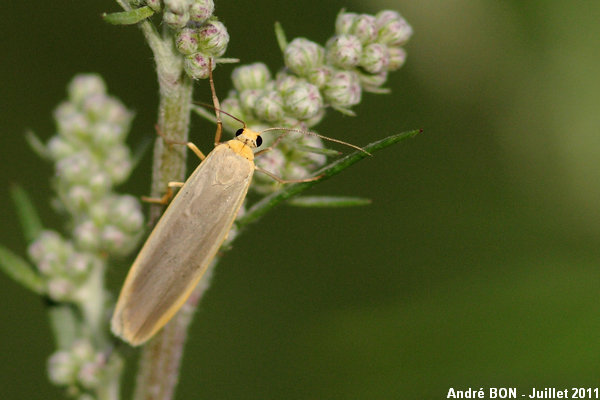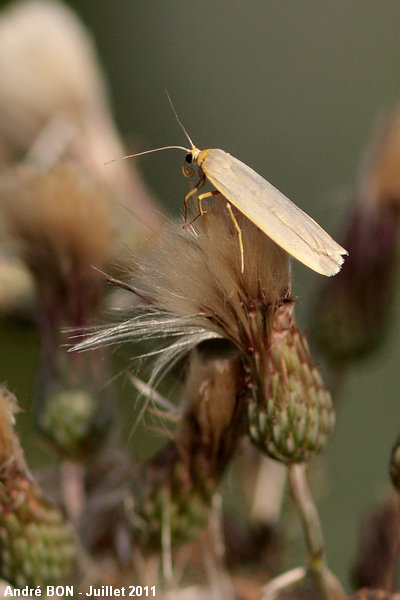


| Common Footman (Eilema lurideola (Zincken, 1817)) |



|
|
Scientific name: Eilema lurideola (Zincken, 1817) Common name: Common Footman French name: Lithosie complanule, Lithosie plombée Order: Lepidoptera Suborder: Heterocera Family: Erebidae Subfamily: Arctiinae Wingspan: 31-38 mm. Biotope: Open woodlands, woodland edges, bushy places, hedgerows, meadows. Geographic area: Europe, Asia east to Japan. Near-East. Flight time: June-August. Number of generations : 1 Caterpillar: Black with many spines and a lateral orange stripe. Host plant: Lichens on trees and on rocks. |
The Common Footman, when at rest, holds its fore wings folded flat one on the other. The fore wings are a grey colour with a thin yellow stripe on the costal edge which strongly tapers just before the apex. The tip of the abdomen is yellowish. The head and the legs are yellow. The hind wings are yellowish. There are similar species that you can tell apart by looking at the yellow edge on the fore wings. The Scarce Footman (Eilema complana) shows a yellow stripe on the costal edge of the fore wings with a constant width up to the apex. When at rest, the fore wings are more held rolled up than held flat. This is an important criteria to tell it apart from Eilema lurideola. The last third of the abdomen is yellow, this colour is limited to the tip on Eilema lurideola. The Hoary Footman (Eilema caniola) holds its fore wings rolled up when at rest. The Dingy Footman (Eilema griseola) also shows fore wings folded flat when at rest. However they appear slightly wider with a curved costal edge. The yellow costal edge stripe gets thinner and thinner from half length to the apex. The neck is grey while it is more yellow on Eilema lurideola. The Common Footman is attracted to light. |
| [To know more about the Common Footman] [Next picture] [Top] |

|
The wings folded flat one on the other with a yellow costal edge tapering at the apex and a yellow neck seem to indicate the Eilema lurideola species. |
| [To know more about the Common Footman] [Next picture] [Previous picture] [Top] |

|
I have observed this Common Footman next to a woodland edge. |
| [To know more about the Common Footman] [Previous picture] [Top] |

|
In fact things are not so simple with the members of the Eilema genus. There is very little difference between species and my lack of experience may lead to erroneous conclusions. I have considered that this specimen was showing folded flat wings and not rolled up wings but I have hesitated some time before making the decision. It would be better to have this species identification confirmed by an expert. The tapering yellow costal edge is enough to discard the Eilema complana species and the narrow wings are enough to discard the Eilema griseola species. So there is still a small doubt with the Eilema caniola species. |